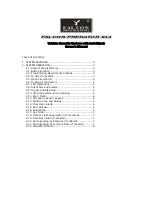
INSTALLATION AND MAINTENANCE INSTRUCTIONS
HD103B
Conventional Photoelectric Smoke& Heat Detector
SPECIFICATIONS
Operating Voltage Range:
9 to 28VDC Volts Non-polarized
Standby Current:
≤
60µA @ 24 VDC
Maximum Alarm Current (LED on: )
≤
30mA @ 24 VDC
Operating Humidity Range: 10% to 93% Relative Humidity, Non-condensing
Operating Temperature Range:
14°F to 120°F (-10°C to 49°C)
Smoke Sensitivity: 1.06
±
.26%FT.
Fixed Temperature Rating: 135°F (57°C)
Rate of Rise Detection: Responds to greater than 15°F/min
Height: 2.2˝ (55 mm) installed in Base
Diameter:
4.0˝ (103 mm)
Weight: 5.5 oz. (155 g)
INSTALLATION
BEFORE INSTALLING
NOTICE:
This manual should be left with the
owner/user of this equipment.
IMPORTANT:
The detector must be tested and
maintained regularly following NFPA 72 requirements.
The detector should be cleaned at least once a year.
GENERAL DESCRIPTION
The device is photoelectronic detector uses a state of-the-
art optical sensing chamber. This detector is designed to
provide open area protection and to be used with most
conventional fire alarm control panel.
Two LEDs on each detector provide local 360° visible
alarm indication. They flash every 3~5 seconds indicating
that power is applied and the detector is working
properly. The LEDs latch on in alarm. LEDs will be off
when a trouble condition exists indicating that the
detector sensitivity is outside the listed limit. The alarm
can be reset only by a momentary power interruption.
INSTALLATION
NOTE
: All wiring must conform to applicable local
codes, ordinances, and regulations.
NOTE
: Verify that all detector bases are installed, that
the initiating-device circuits have been tested, and that the
wiring is correct.
Remove power from initiating-device circuits before
installing detectors.
1. Wire the sensor base per the wiring diagram, Figure 1.
2. Install the sensor into the sensor base. Push the sensor
into the base while turning it clockwise to secure it in
place.
3. After all sensors have been installed, apply power to
the control unit.
4. Test the sensor(s) as described in the TESTING
section of this manual.
5. Notify the proper authorities that the system is in
60mmm
�





















